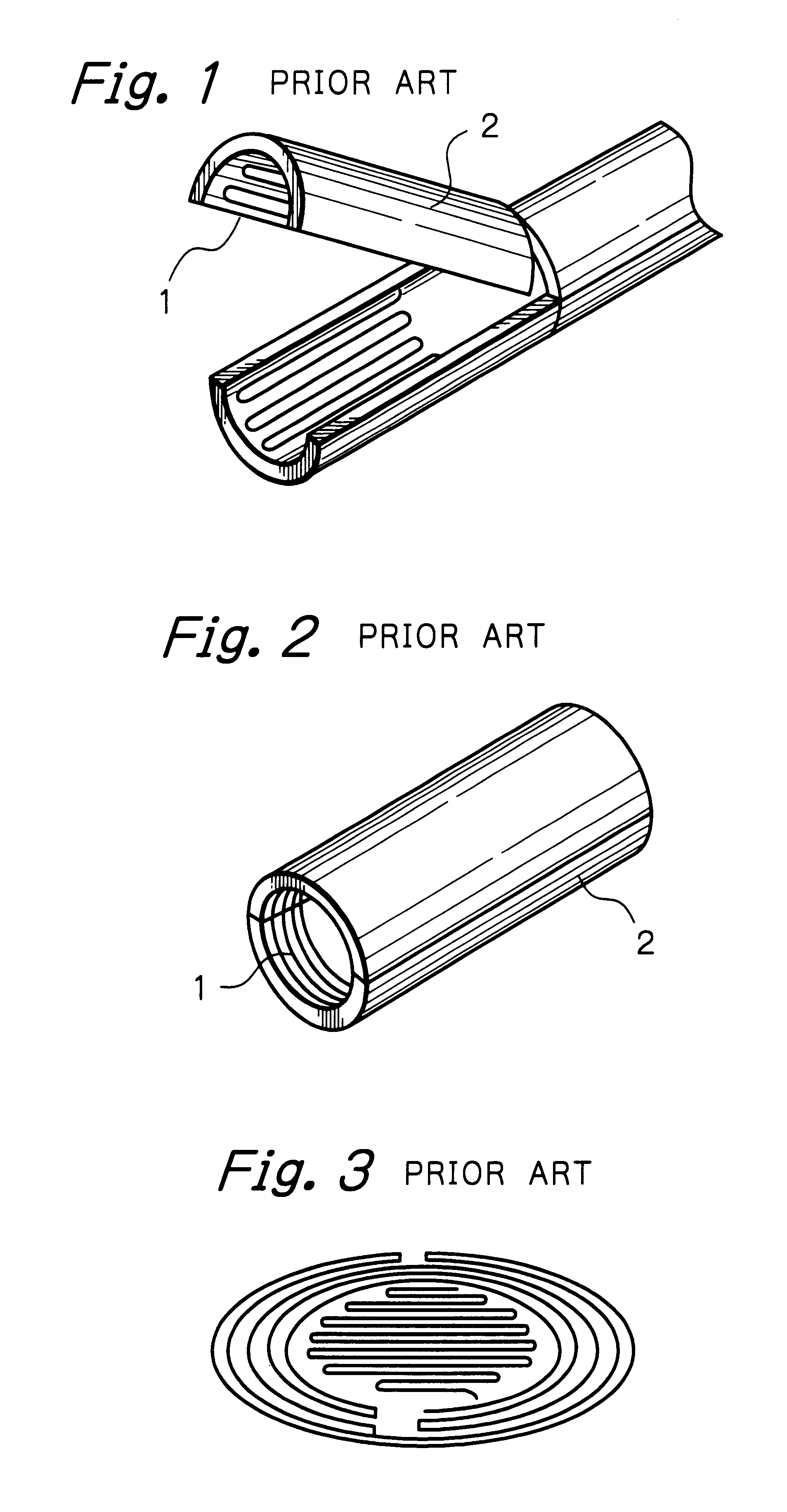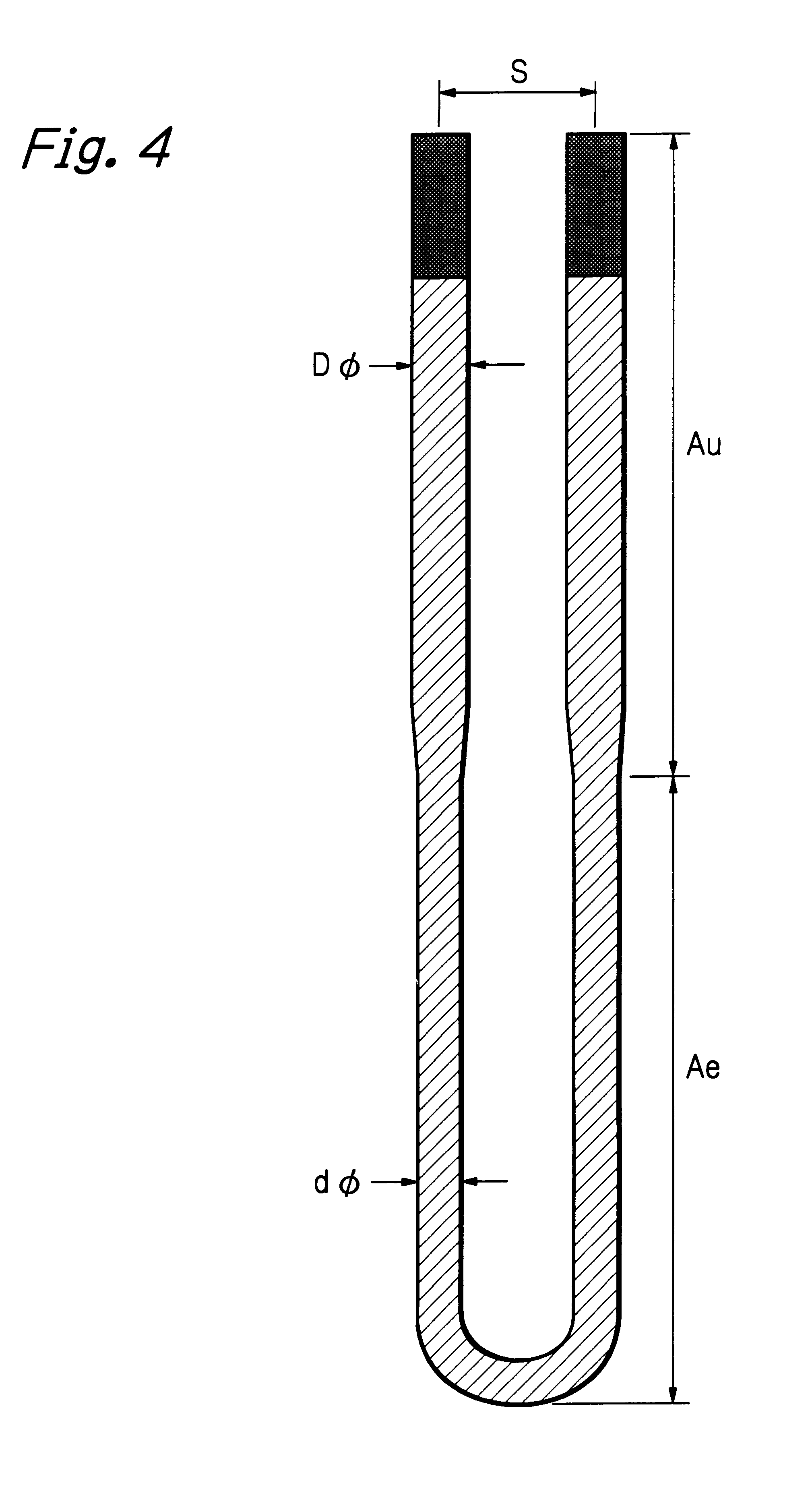Molybdenum disilicide heating element and its production method
a technology of molybdenum disilicide and heating element, which is applied in the direction of ohmic resistance heating, electric heating, basic electric elements, etc., can solve the problems of dramatically reducing the heat capacity of the heat treatment furnace, unsatisfactory user experience, and the life of the mosi.sub.2 heating element, so as to achieve the effect of prolonging the life of the heating elemen
- Summary
- Abstract
- Description
- Claims
- Application Information
AI Technical Summary
Benefits of technology
Problems solved by technology
Method used
Image
Examples
examples 3-6
The MoSi.sub.2 used had 1.7 .mu.m of average particle diameter. The MoSi.sub.2 used contained as impurities 0.006 mass % of Fe, 0.001 mass % or less of Cu, 0.008 mass % of Al, 0.001 mass % or less of Ca, 0.001 mass % or less of Mg, 0.005% or less of Na and 0.001 mass % or less of K. The clay mineral used was artificial (synthesized) Sumectite clay, which contained as impurities 0.005 mass % of Fe.sub.2 O.sub.3, 3.98 mass % of Na.sub.2 O, and 0.02 mass % of K (trade name--Sumecton SA, produced by Kunimine Industries Co., Ltd.). MoB, which was also used, had 2.6 .mu.m of average particle diameter, and contained as impurities 0.01 mass % of Fe and 0.001 mass % of Cu. The MoSi.sub.2, clay mineral and MoB were blended in the proportions shown in Table 2. The rod-shaped sintered materials having 3 mm and 6 mm in diameter were produced by the method of Example 2. The treatment for removing Na was then carried out at 1500.degree. C. for 5 hours, while evacuating the furnace interior to redu...
examples 7 , 8
Examples 7, 8
The MoSi.sub.2 used in Example 1 was also used in these examples. The synthesized kaolinte (product of Toyo Denka Co., Ltd.) additionally used in these examples had 45.9 m.sup.2 / g of specific surface area, and contained as impurities 0.09 mass % of Fe.sub.2 O.sub.3, 0.06 mass % of Na.sub.2 O and 0.01 mass % of K.sub.2 O. The MoSi.sub.2 and the synthesized kaolinite were blended in the proportions shown in Table 3. The U-shaped heating elements were produced by the method of Example 1 and the same tests as in Example 1 were carried out.
examples 13 and 14
The material of Example 3 and the material of Example 10 were used to produce the meander-type multi-shank heating element as shown in FIG. 9. Two kinds of meander-type multi-shank heating elements were produced using rods of 3 mm in diameter. One element had forty (40) shanks with the shank pitch (d) of 15 mm and the shank length of 120 mm. The other had thirty two (32) shanks with the shank pitch (d) of 20 mm and the shank length of 260 mm. The 40-shank elements were mounted on the top and bottom zones and the 32-shank elements were mounted on the center zones of a semi-cylindrical insulating mould of 200 mm in inner radius and 950 mm in length. The insulating mould was made of ceramic fiber. A pair of semi-cylindrical mould, on which the four meander-type multi-shank heating elements were mounted as described above, were combined to form the heating element module in a tubular form and mounted in a batch-type heating furnace. In FIG. 9, "n" means a number of shanks.
The performanc...
PUM
| Property | Measurement | Unit |
|---|---|---|
| temperature | aaaaa | aaaaa |
| temperature | aaaaa | aaaaa |
| average particle diameter | aaaaa | aaaaa |
Abstract
Description
Claims
Application Information
 Login to View More
Login to View More - R&D
- Intellectual Property
- Life Sciences
- Materials
- Tech Scout
- Unparalleled Data Quality
- Higher Quality Content
- 60% Fewer Hallucinations
Browse by: Latest US Patents, China's latest patents, Technical Efficacy Thesaurus, Application Domain, Technology Topic, Popular Technical Reports.
© 2025 PatSnap. All rights reserved.Legal|Privacy policy|Modern Slavery Act Transparency Statement|Sitemap|About US| Contact US: help@patsnap.com



